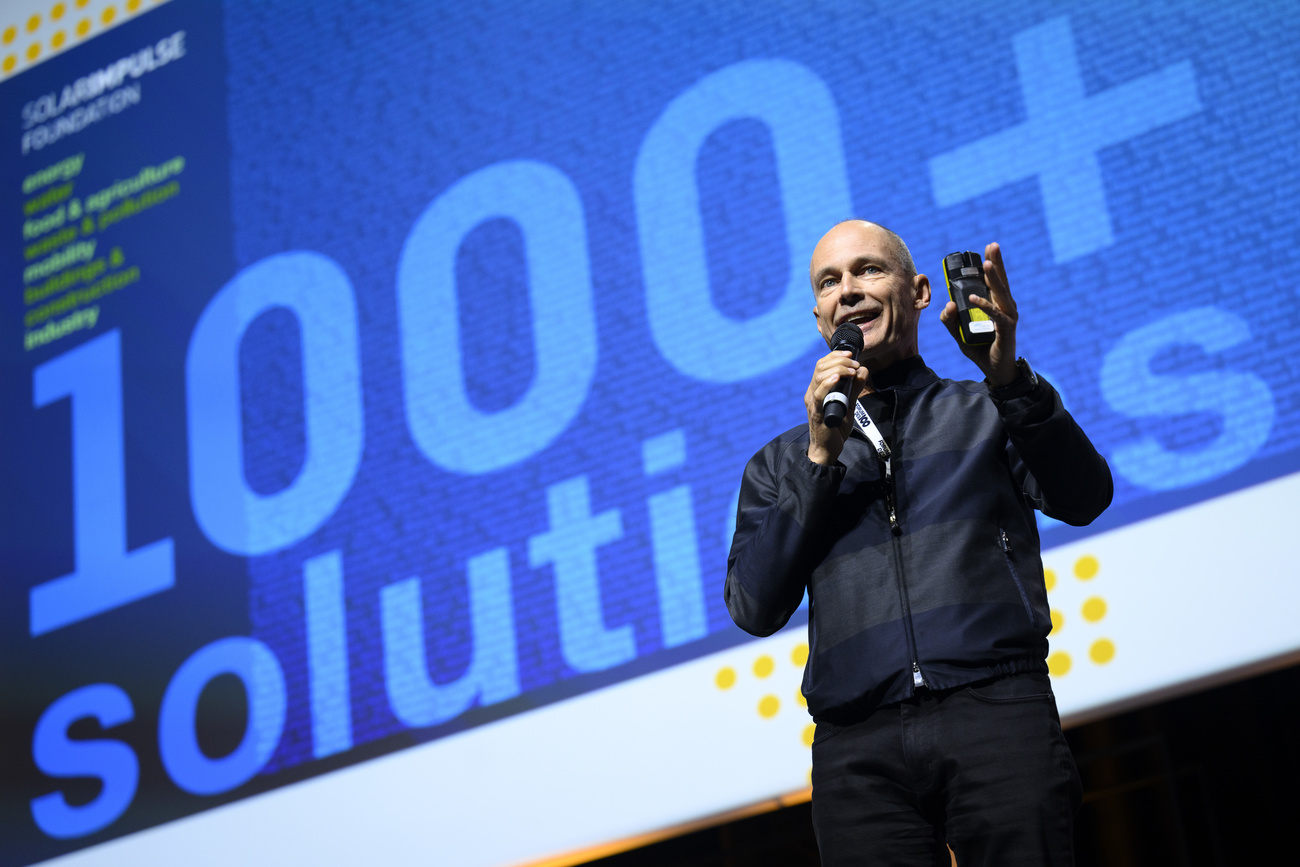Climate change is forcing aid agencies to change how they work

The climate crisis is driving humanitarian needs to unprecedented highs. Aid agencies are advocating for a shift from responding to predictable shocks to anticipating their impacts and offering help before disasters strike, a message they brought to COP27.
In the Horn of Africa, the United Nations estimates thatExternal link an unprecedented drought has pushed nearly 21 million people to the brink of famine. Meanwhile massive floods in PakistanExternal link last summer killed some 1,700 people and destroyed dozens of healthcare facilities, leaving hundreds of thousands of people with limited access to medical care while contaminated flood waters increase the risk of malaria and cholera outbreaks.
Climate change is making such extreme weather events more frequent and more intense. It is also – together with conflict and the Covid-19 pandemic – driving humanitarian needs in vulnerable countries to new heights.
“Most of the money that’s available to humanitarian agencies, who are dealing with bigger problems than they’ve ever had to face, is provided after the tragedy has struck, in reaction to it,” says Mark Lowcock, a senior fellow at the Center for Global Development, a think tank headquartered in Washington, DC.
A changing climate has prompted humanitarian organisations to rethink the way they operate. The International Federation of Red Cross and Red Crescent SocietiesExternal link (IFRC) and UN aid agenciesExternal link are advocating for a shift from responding to predictable emergencies to anticipating their impacts and providing local communities with support before disasters strike.
“We need to move the whole humanitarian system to act more frequently on the basis of what we know is about to happen rather than react to things that have already happened,” says Lowcock, who served as UN relief chiefExternal link between 2017 and 2021.
Current technology is making this new approach – called anticipatory action, or early action – easier to implement than in the past. Artificial intelligence models can improve weather predictions, mobile phones can receive early warnings, while drones can help map and monitor vulnerabilities.
“The thing about climate change is you can predict bad events in advance. If an earthquake strikes, you might get a few seconds’ notice. On the other hand, when storms are brewing and threaten islands, because of the quality of our technology, we now know days in advance about the path of storms,” says Lowcock, who adds that the same applies to floods and droughts.
Acting early
So how does anticipatory action work? Catherine Jones, who works with the UN Food and Agriculture Organization (FAO) in the Asia-Pacific region, one of the hardest hit by climate change, gives a concrete example.
“Ahead of Typhoon Noru, that hit Vietnam in late September, the FAO distributed unconditional cash alongside watertight drums to communities expected to be affected so that they could protect themselves,” she says.
Farming and fishing communities were able to shield their food, grains, and store clean water, while cash was primarily used to buy essential supplies before being cut off from the market.
That early action plan had been prepared by the FAO together with the government before the start of typhoon season in the region. Its financing had been pre-agreed through a partnership between the FAO and the European Union. Forecasts showing with a high likelihood that provinces in Central Vietnam would be affected by winds exceeding Typhoon Category OneExternal link level triggered the plan three days in advance.
Proponents of this approach argue that it not only saves more lives but is also a more cost-effective and dignified way of giving help, as preventable negative outcomes are avoided, and local actors are able to take matters into their own hands.
The UN has foundExternal link that the cost per person it supports could be cut in half by acting early. Flooding in Bangladesh in 2020 for which the UN launched an early action cost the organisation $13 (CHF12.40) per person, while a response plan to a similar situation in 2019 had cost $26 per person.
No easy task
Preparing for a natural hazard calls for an in-depth understanding of its impact on people on the ground. This requires the involvement of local governments, aid organisations, and individuals.
“In the Philippines, the local Red Cross has anticipatory action plans for typhoons. And on one island, the early action is distributing shelter strengthening kits so that houses don’t get destroyed. But if the typhoon goes to the next island – it’s the same typhoon, just a different island – the Red Cross does something different. It does early harvesting because agriculture is what most people do there for a living,” says Raymond Zingg, who works with the IFRC in Bangkok to coordinate anticipatory action partnerships and technical support in the Asia-Pacific region.
When drafting an early plan, deciding which climate threat to focus on is often difficult.
“I think the main challenge that we have is that there are so many hazards coming at once. You can spend your time planning for one risk, but then you’ve got another one coming at you,” says Jones of the FAO.
Countries such as Pakistan and South Sudan, which have faced historic floods in recent months, illustrate this difficulty, as both have also experienced severe droughts in the past.
To move as quickly as possible once a forecast triggers an early action, local humanitarian actors need to have the necessary material ready, and their volunteers already trained. Funding must be made available each year for them to prepare, even when there is no crisis, a potential deterrent to donors.
“When you are in the difficult position of having to decide: ‘do I want to invest now in something that may happen later, or do I want to give to something that is happening already now?’ That is a normal struggle,” says Nazira Lacayo of the IFRC in Geneva, who is responsible for the review of the anticipatory action plans Red Cross and Red Crescent national societies submit to apply for funding.
Scaling up
As of November 2022, the IFRC had approved 32 early action plans from 22 Red Cross Red Crescent national societies, each covering between 1,000 and 20,000 people. As of October 2022External link, the IFRC Disaster Response Emergency Fund (DREF) had allocated CHF 4.2 million (9% of its total allocations) for anticipatory action, the rest (CHF 43.3 million) was allocated for emergency response. The organisation hopes to increaseExternal link the DREF allocations to CHF 100 million by 2025, a quarter of which would be used to finance early action.
“It would be great to grow the pie and not to divide it differently. Sadly, in today’s world both anticipation and emergency response are needed. The scale of weather events, such as the flooding in Pakistan, you can try to mitigate their impact, but you won’t be able to completely avoid that impact,” says Lacayo.
Ultimately, early action is not a one-size-fits-all solution to address the consequences of climate change. Other longer-term efforts to build resilience and reduce risks are also needed. And while this approach helps preserve lives and livelihoods, it is still a response to the effects of climate change. More should be done to tackle its root causes.
“If we want to avoid mass loss of life in these tragedies, there’s no alternative but to give the humanitarian agencies more money. But it would be better also to tackle the underlying causes, like conflict, like pandemics, like climate change. That’s the big message here,” says Lowcock.
Edited by Imogen Foulkes
Humanitarian organisations have over the years increased their advocacy efforts at UN Climate Change conferences. This year, several UN agencies, and other large NGOs such as the IFRC have sent teams to speak at COP27 in Sharm El-Sheikh, Egypt.
The UN relief chief, Martin Griffiths, told world leadersExternal link on November 8 that the humanitarian community, which works with local populations in the most vulnerable countries, could share its experience to help the international community find better ways to tackle the climate crisis.
“But the pace and scale of change is rapidly outstripping our ability to respond, stretching an overburdened humanitarian system to breaking point. That’s why I want to be clear that I’m not here to seek funding for humanitarian work. The climate crisis is not a crisis that the humanitarian system can solve,” Griffiths added.
At COP27, humanitarian aid workers are advocating for countries to cut down greenhouse gas emissions and scale up funding for climate adaptation, and loss and reparation. According to them, that money should go directly to vulnerable communities. They are also calling for the implementation of early warning systems that mitigate the impact of disasters.
On November 15, the IFRC however warnedExternal link that negotiations were “missing the ambition needed to protect those hardest hit by climate change”. At an event organised by OCHA on November 14, Dane McQueen of the Office of the United Arab Emirates Climate Envoy, whose country will host COP28 next year, saidExternal link he appreciated the “weaving of humanitarian experience” in the often “very abstract” talks on adaptation, and loss and damage at these conferences. He suggested that normalising humanitarian tools like anticipatory action could be an area on which consensus could be built next year.

More
Inside Geneva: COP27, climate change, and health

In compliance with the JTI standards
More: SWI swissinfo.ch certified by the Journalism Trust Initiative














You can find an overview of ongoing debates with our journalists here . Please join us!
If you want to start a conversation about a topic raised in this article or want to report factual errors, email us at english@swissinfo.ch.